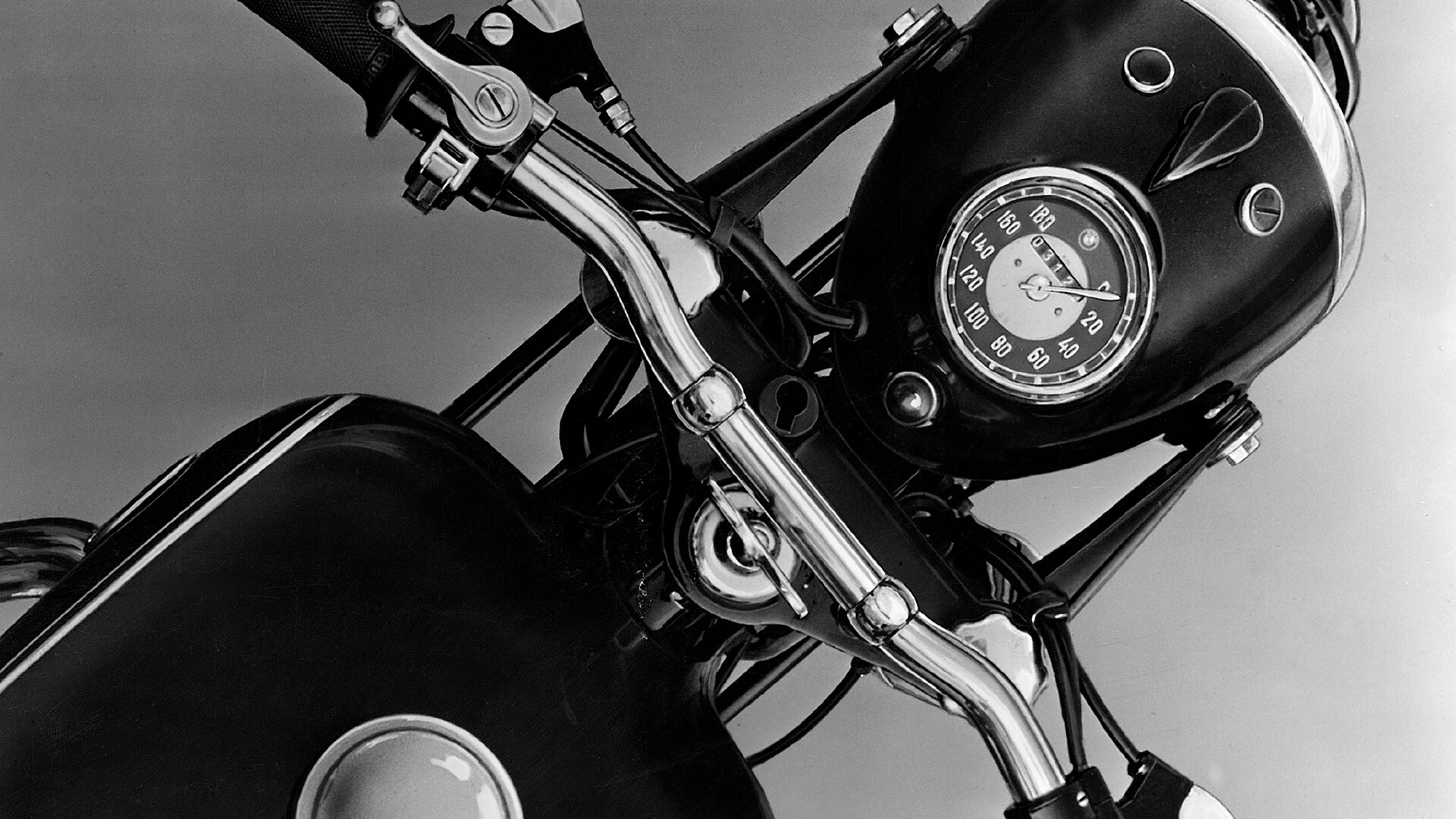Back on top.
BMW enters the international stage with top models and legendary victories.
The 1950s are marked by sporting successes. BMW achieves remarkable top speeds with a series-manufactured machine. Furthermore the drivers of motorcycle teams win world championship titles.
The 100 mile racer.
The 100 mile racer.
With the R 68, BMW develops a top sporting product. With a standard top speed of 160 kph, the BMW R 68 is regarded as the top model of the fifties. With the presentation of the R 68 100-mile-racer at the International Bicycle and Motorcycle Show (IFMA), BMW demonstrates its return to the top class of international motorcycle construction.
Read more
BMW takes the plunge into motor sport.
A small edition of the legendary BMW RS model was produced for motor sport with valve control by means of an upright shaft. The model attained an incredible speed of 200 km/h and a number of private riders achieved countless victories on the racetrack both in Germany and beyond. In 1954, BMW began a regular spate of wins in the world championships for motorcycle and side-car combinations. Wilhelm Noll and Fritz Cron were the first to take the world championship title with the RS side-car combination. In addition, Noll also used the bike to set another speed record for BMW, reaching 280 km/h. Losing by a short distance Walter Zeller was runner-up in the 1956 championships, achieving the best placing for a BMW solo rider on the racing circuit.
+ Read more
The motorcycles of the 1950s
1951: R 51/3.
1951: R 51/3.
The familiar chassis now had new engines with a central camshaft which also drove the magneto. The dynamo was placed to the front on the end of the crankshaft Instead of two chain-drive camshafts, a central camshaft was used.
Read more
1952: R 68.
1952: R 68.
With only the valve covers and narrow fenders to differentiate it in visual terms, the new sports bike also had larger valves and carburettors, a different camshaft, a higher compression ratio and needle-bearing rocker arms. The output of 35 hp enabled the R 68 to achieve a top speed of 160 km/h. This made the BMW R 68 the first German "100-mile racer".
Read more
1954: R 25/3.
Source: BMW Group Archive; Photographer: BMW Werkfoto.
1954: R 25/3.
The R 25/3 featured some fundamental innovations. As well as a more powerful engine, full hub brakes, 18 inch wheels and a hydraulically damped telescopic fork ensured comfort, safety and motorcycling pleasure. With 47,700 units sold, the R 25/3 remained the biggest-selling BMW Motorrad model until well into the 1990s.
Read more
1955: R 50.
1955: R 50.
The BMW R 50 was the first model in a new generation of motorcycles with full rocker chassis, the rear wheel runs in a long swinging arm with spring struts. The front wheel had an offset rocker based on the Earles design, also with spring struts This was the first time a cup spring coupling and a three-shaft, four-speed transmission with damper were used. As the R 50 was a very comfortable bike with 26 hp and a top speed of 140 km/h, as well as BMW's proverbial reliability, it soon became very popular with government agencies in Germany and abroad.
Read more
More decades
- 1920s.
- 1930s.
- 1940s.
- 1960s.
- 1970s.
- 1980s.
- 1990s.
- 2000s.
1920s.
The foundations.
At the Berlin Motor Show in September 1923, the starting signal was given for the construction of BMW motorcycles: The R 32 is the first BMW motorcycle, developed by Max Friz. The world-renowned boxer engine will be the manufacturers main characteristic.
1930s.
Of records and races.
In the 1930s, the engineers not only considered performance development, but also introduced, for example, the hydraulically damped telescopic fork and the elaborately designed OHV boxer engine - with unique consequences and successes.
1940s.
On with pioneering spirit.
After the turmoil of the war, BMW manages a new start with motorcycle production. First they build the R 24 a single-cylinder motorcycle limited to 250 cc.
1960s.
Up turn.
In Berlin-Spandau, where aircraft engines were built up to 1945 and subsequently tool machine facilities were installed, the BMW motorcycles are given their new home and Berlin air in their tyres. In keeping with the new motorcycle boom, BMW manufactures a completely newly developed series with the /5 models.
1970s.
Protection against wind and weather.
A new era is being introduced: Cockpit and full fairings make driving on the motorcycle more comfortable. There are sporty motorbikes. In particular, the R 90 S is a popular design classic - not least because of its elaborate two-tone paintwork.
1980s.
New technology, new segment.
The motorcycle manufacturer surprises with pioneering innovations and the new segment of travel enduro. After the revolutionary single-arm swing from 1980, the BMW Paralever system is introduced in 1987 in the R 100 GS.
1990s.
Pioneer, trendsetter.
The new four-valve boxer with electronic engine management and the first BMW single-cylinder motorcycle since 1966 come on the market in the 1990s. In addition, in the spring of 1991, BMW Motorrad became the world's first motorcycle manufacturer to offer a regulated three-way catalytic converter for motorcycles.
2000s.
Sportier and more dynamic than ever.
Several new models and technical innovations are driving the growth at BMW Motorrad: the new K-Series now comes with a transversely mounted engine, and the newly developed F-Series fuels the mid-range segment. At the end of the decade, BMW Motorrad will introduce one of the most important new releases on the market - the S 1000 RR marks the first time that the brand has entered the world of superbikes.






